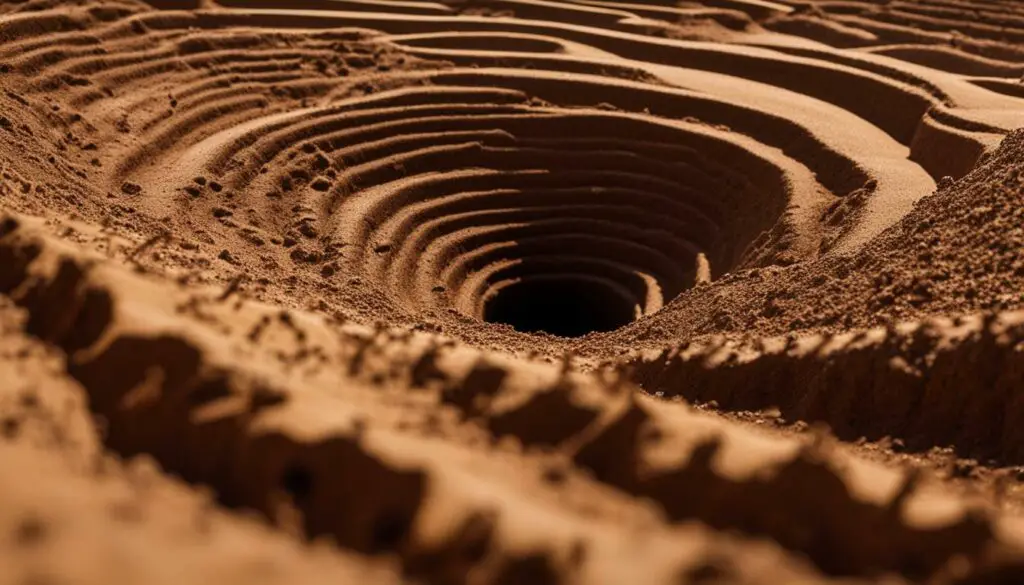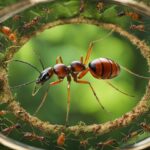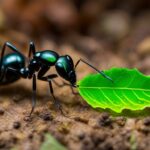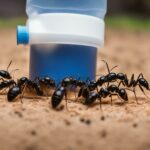Ant tunneling behavior patterns are a fascinating aspect of the complex underground world of ants. These small insects are capable of constructing intricate tunnel systems that serve various purposes, such as housing the colony’s queen, nurturing the young, cultivating fungus for food, and disposing of waste. The construction of these tunnels is a remarkable feat, especially considering the size of the ants. Researchers from Caltech have recently uncovered some of the secrets behind how ants build these complex structures, shedding light on their behavior and mechanisms.
Key Takeaways:
- Ants construct intricate tunnel systems for various purposes.
- Researchers from Caltech have uncovered secrets behind ant tunnel construction.
- Ant tunneling behavior patterns are a remarkable feat considering the ants’ size.
- The study of ant behavior provides valuable insights into their mechanisms.
- Understanding ant tunneling behavior can help solve mysteries and improve our knowledge of the underground world of ants.
The Driving Question: Do Ants “Know” How to Dig Tunnels?
When it comes to ant tunneling behavior, one question has puzzled researchers for years: Do ants possess a knowledge or strategy behind their digging habits, or are they simply blindly digging? This fundamental question drove a team of scientists from Caltech to investigate the intricate world of ant tunnel construction.
The researchers at Caltech hypothesized that ants dig their tunnels in a deliberate and strategic manner. They believed that ants have the ability to sense the force chains within the soil and avoid digging in areas where these forces are too strong. To illustrate this hypothesis, they likened ants’ digging behavior to playing the game Jenga, where the ants tap the grains of soil to assess the mechanical forces acting on them.
“Ants dig in a deliberate and strategic manner, akin to playing Jenga, where they tap the grains of soil to assess the mechanical forces acting on them.”
The Influence of Soil Mechanics on Ant Tunneling
Soil mechanics play a crucial role in ants’ digging habits. By tapping the soil grains, ants can determine the stability and mechanical forces acting on the particles. They use this information to strategically choose where to dig and avoid areas where the force chains are too strong.
This ability to perceive and respond to the forces within the soil is a remarkable example of the intricacies of ant behavior. It highlights the sophisticated nature of ants’ tunneling habits and the intelligence exhibited by these tiny creatures.
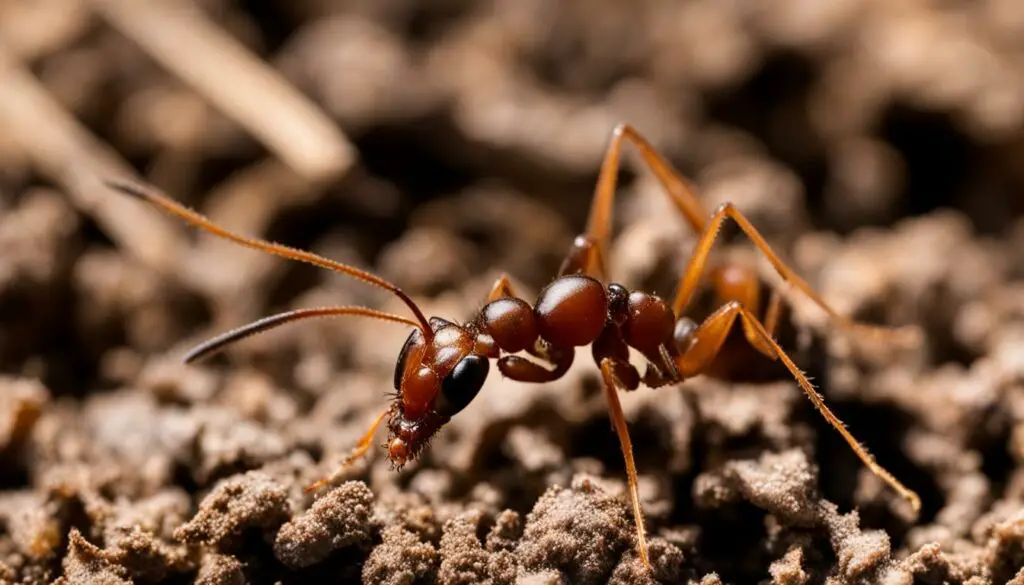
Comparing Ants to Architects
Understanding ants’ knowledge of digging and their ability to navigate the complex world of soil mechanics is not only fascinating from a scientific perspective but also has practical implications. The research conducted at Caltech can provide valuable insights into efficient tunnel construction techniques that can be applied in various engineering and construction fields.
By studying ants’ strategic digging habits, architects and engineers can learn from nature’s design and apply these principles to create more efficient and stable structures. Just as ants build their tunnels by assessing the forces within the soil, engineers can design structures that optimize the use of materials and withstand external pressures.
Studying Ants: The Path to Unraveling their Behavior
Studying ants and understanding their behavior is a fascinating endeavor that requires careful observation and scientific investigation. Through extensive research and collaboration with ant experts, we have delved into the intricate world of ant tunneling behavior. By culturing ants and analyzing their digging habits, we have gained valuable insights into their behavior and the mechanisms behind their tunnel construction.
Working alongside ant expert Joe Parker, we have learned how to breed and handle ants in a controlled environment. This has allowed us to closely monitor their tunneling activity and track their progress using X-ray imaging. Through our research, we have discovered that ants exhibit remarkable efficiency in digging their tunnels. They strategically take advantage of the inside edges of containers, minimizing their workload by utilizing the container’s structure. Additionally, ants dig their tunnels as straight as possible and as steeply as the angle of repose allows, ensuring the stability of the tunnel walls.
Our findings have provided valuable insights into the behavior of ants and how they construct their tunnels. By understanding their digging habits and the factors that influence their tunneling behavior, we can gain a deeper appreciation for these remarkable creatures. This knowledge can also have practical applications, as we can apply lessons from ant behavior in various fields such as engineering, swarm intelligence, and microclimate control.
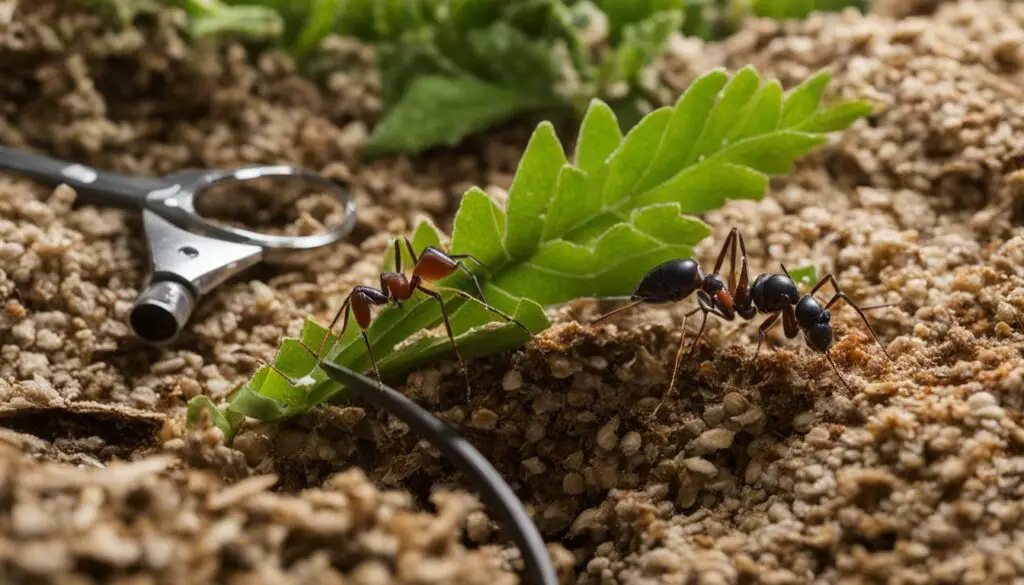
Understanding Ant Breeding and Behavior
- Ants exhibit remarkable efficiency in digging tunnels, taking advantage of the container’s structure to minimize their workload.
- They dig their tunnels as straight as possible and as steeply as the angle of repose allows, ensuring stability.
- Studying ant behavior and breeding can provide insights into swarm intelligence and microclimate control.
“Through our research, we have discovered that ants exhibit remarkable efficiency in digging their tunnels.”
The Physics of Ant Tunnels: Efficiency and Stability
Ants are masters of tunnel construction, utilizing remarkable physics to create efficient and stable structures. The intricacies of their digging behavior reveal a complex understanding of force chains and optimal tunnel design. By studying the physics behind ant tunnels, we can gain insights into their efficient digging techniques and the stability of their underground networks.
One key aspect of ant tunnel construction is their ability to exploit the inside edges of containers. Ants dig along these edges, utilizing the container as part of the tunnel structure. This clever strategy reduces the amount of work required to create the tunnel and ensures greater stability by incorporating the existing structure.
Moreover, ants meticulously dig their tunnels as straight as possible, taking the shortest path between two points. This efficient digging technique minimizes the amount of excavation required and allows ants to navigate their tunnels with ease. Additionally, ants dig their tunnels at the steepest angle allowed by the angle of repose, ensuring the stability of the tunnel walls and preventing collapses.
The physics of ant tunnels is a captivating aspect of their behavior and provides valuable insights into their remarkable abilities. By harnessing the power of efficiency and stability, ants are able to construct complex tunnel systems that support the survival and thriving of their colonies.
Efficiency and Stability in Ant Tunnel Construction
| Efficiency | Stability |
|---|---|
| Ants dig along the inside edges of containers, utilizing the existing structure. | Ants dig their tunnels as straight as possible, reducing excavation and minimizing the risk of collapses. |
| By incorporating the container’s structure, ants reduce the amount of work required for tunnel construction. | Ants dig their tunnels at the steepest angle allowed by the angle of repose, ensuring stable tunnel walls. |
| Efficient digging techniques enable ants to navigate their tunnels with ease. | Stable tunnel walls support the survival and thriving of ant colonies. |
Uncovering the Mystery: How Ants Build Long-Lasting Structures
Ants have long been admired for their ability to construct intricate and long-lasting tunnel structures. The mystery behind their construction methods has fascinated researchers for years. Through recent studies, scientists have made significant progress in unraveling the secrets of ant architecture, shedding light on how these tiny creatures build structures that can stand the test of time.
One of the key discoveries in understanding ant tunnel construction is the subtle rearrangement of force chains. By selectively removing grains of soil in a specific pattern, ants strengthen the walls of their tunnels and alleviate pressure from the areas where they are actively working. This strategic manipulation of force chains allows ants to create stable and durable structures that can persist for decades.
“By selectively removing grains of soil in a specific pattern, ants strengthen the walls of their tunnels and alleviate pressure from the areas where they are actively working.”
This insight into ant tunnel construction has broader implications beyond the insect world. Engineers and architects have been studying ant nest engineering to gain inspiration for more efficient and resilient designs. Ants’ ability to manage climate, circulation, and spatial efficiency within their nests provides valuable lessons for creating sustainable infrastructure and optimizing resource allocation.
As our understanding of ant architecture continues to evolve, there is still much to learn from these remarkable creatures. Their ability to build long-lasting structures through subtle rearrangements of force chains showcases the ingenuity and complexity of nature’s designs.

Table: Comparing Ant Tunnel Construction Methods
| Species | Tunnel Construction Method |
|---|---|
| Species A | Selective removal of soil grains to strengthen tunnel walls |
| Species B | Layering soil grains to create reinforced tunnel structure |
| Species C | Utilizing external materials to fortify tunnel walls |
Through comparative analysis of different ant species, researchers have identified variations in tunnel construction methods. While each species has its unique approach, the underlying principle of optimizing tunnel strength and stability remains consistent.
- Ants selectively remove soil grains to reinforce tunnel walls.
- Some species layer soil grains to create a reinforced structure.
- Others employ external materials to fortify tunnel walls.
By understanding the intricacies of ant tunnel construction, we can gain valuable insights into the principles of efficient and long-lasting structural design.
Lessons from Ant Nest Engineering
Ants are remarkable architects, displaying a level of engineering prowess that has captivated the attention of scientists and engineers. By studying the intricate designs of ant nests, researchers have gained valuable insights into swarm intelligence, microclimate control, and efficient resource allocation.
Ant nests are sophisticated structures that optimize space, manage circulation, and regulate temperature and humidity. These nests, often consisting of chambers and tunnels, are meticulously built to support the needs of the ant colony. By observing and analyzing the organization and functionality of these nests, researchers have been able to apply lessons from nature to various fields.
Swarm Intelligence
Ants exhibit a collective intelligence known as swarm intelligence. In a colony, individual ants work together, coordinating their efforts to achieve common goals. This decentralized decision-making and collaboration allow ants to solve complex problems and adapt to changing environments. By studying ant nest engineering, scientists have gained insights into how collective intelligence can be applied to human systems, such as computer networks or traffic management.
Efficient Resource Allocation
The design of ant nests reflects an efficient use of resources. Ants construct their nests in a way that minimizes energy expenditure and maximizes functionality. For example, they create specialized chambers for different purposes, including nurseries for raising larvae, food storage areas, and ventilation systems. Understanding how ants allocate resources in their nests can inspire more sustainable practices in human architecture, where space optimization and resource efficiency are crucial.
Microclimate Control
Ants have a remarkable ability to regulate the microclimate within their nests. They create ventilation systems that allow air circulation while managing temperature and humidity levels. By observing the intricate network of tunnels and chambers that facilitate this control, researchers have gained insights into natural ventilation systems and sustainable building practices. The principles of microclimate control observed in ant nests can inform the design of energy-efficient buildings that optimize comfort and reduce reliance on artificial climate control systems.
By studying the engineering marvels of ant nest construction, scientists and engineers have unlocked valuable lessons that can be applied to various fields. The principles of swarm intelligence, efficient resource allocation, and microclimate control demonstrated by ants provide inspiration for innovation and sustainable design.

Fire Ants: Construction and Distinction as a Species
Fire ants, a particular species of ants, are known for their aggressive behavior and distinctive physical features. They construct nests that consist of interconnected chambers and tunnels, similar to other ant species. However, fire ant nests are often found in open, sunny areas, and their mounds can easily be identified by their reddish-brown color. Fire ants have elongated bodies, stingers, and segmented bodies that set them apart from other ant species.
These ants exhibit remarkable construction skills, creating complex networks of chambers and tunnels underground. Their nests serve as a hub for the colony, providing shelter, protection, and optimal conditions for the survival and growth of their population.
Fire ants are highly adaptable and resilient, allowing them to thrive in a wide range of environments. They have become a common presence in many parts of the United States, causing concerns due to their aggressive behavior and painful stings. Understanding their nesting habits and physical characteristics is crucial for effective control and management of fire ant infestations.
To further understand the distinct features and construction patterns of fire ants, let’s explore a table that highlights their key characteristics:
| Distinctive Features of Fire Ants | Description |
|---|---|
| Body Shape | Elongated and segmented bodies |
| Mound Color | Reddish-brown |
| Preferred Nesting Areas | Open, sunny areas |
| Nest Structure | Interconnected chambers and tunnels |
By understanding the unique characteristics and nesting behavior of fire ants, we can develop effective strategies to manage their presence and minimize their impact on our surroundings.
Fire Ants: Aggressive Behavior and Nesting Preferences
Fire ants are notorious for their aggressive behavior, especially when their nests are disturbed. These tenacious insects quickly retaliate and defend their colony, making them formidable opponents in the insect world. When provoked, fire ants deliver a painful sting rather than a bite, injecting venom that causes a burning sensation and inflammation. It’s important to exercise caution and avoid disturbing fire ant nests to prevent painful encounters.
Fire ants have specific nesting preferences and are commonly found in sunny, open areas such as lawns, parks, and fields. Their nests consist of a network of interconnected chambers and tunnels, where they raise their young, store food, and protect their queen. By understanding their nesting preferences, we can identify potential areas of infestation and take proactive measures to manage fire ant populations.
To effectively control fire ants and limit their impact on our lives, it is crucial to understand their behavior. These insects are opportunistic feeders and consume a variety of foods, including plants, small insects, seeds, fruits, and worms. Fire ants are known to venture into homes in search of sweet or protein-rich foods, posing a nuisance to homeowners. By implementing preventive measures like smart food storage and maintaining a clean environment, we can minimize the likelihood of fire ant infestations.
Managing fire ant populations can be challenging, and DIY pest control methods may not always be effective. When faced with a significant infestation, it is advisable to seek professional pest control services. These experts have the knowledge, specialized equipment, and responsible treatment methods to comprehensively address fire ant colonies. By engaging professional assistance, we can ensure the thorough elimination of fire ants while minimizing the risks associated with their aggressive behavior.
| Nesting Preferences | Behavior | Prevention |
|---|---|---|
| Sunny, open areas | Aggressive when disturbed | Maintain a clean environment |
| Network of chambers and tunnels | Opportunistic feeders | Proper food storage |
| Enter homes in search of food | Regular yard maintenance |
Fire Ant Diet: Opportunistic Feeders
Fire ants, like many other species of ants, are opportunistic feeders. They have a varied diet that allows them to thrive in various environments, from gardens to kitchens. Fire ants are not picky eaters, and they will consume a wide range of foods to meet their nutritional needs. Their diet includes plants, small insects, seeds, fruits, and even worms.
Fire ants are known for their foraging behavior, constantly searching for food sources to sustain their colony. They are attracted to sweet and protein-rich foods, which provide them with the necessary energy and nutrients. This is why fire ants are often found in homes, as they venture inside in search of accessible food sources.
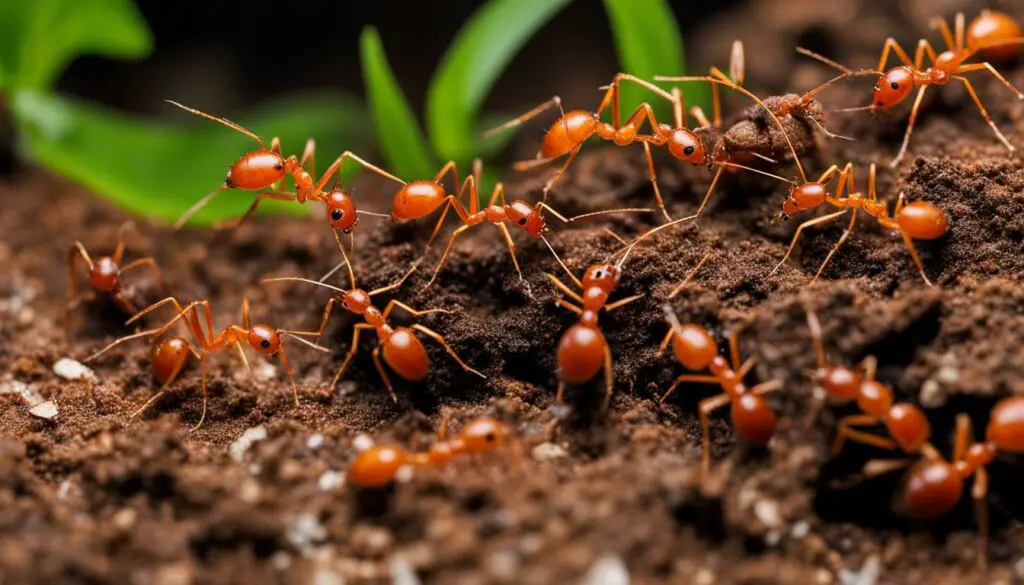
Fire Ant Foraging Behavior
Fire ants have a sophisticated system of communication that allows them to coordinate their foraging activities. When a fire ant finds a food source, it will leave a chemical trail called a pheromone to guide other ants to the food. This pheromone trail becomes stronger as more ants follow it, creating a direct pathway between the nest and the food source.
Fire ants are persistent foragers, and they will not give up easily when searching for food. They can travel long distances in search of resources, and they are capable of quickly depleting food sources in their vicinity. This foraging behavior, combined with their aggressive nature, makes fire ants a formidable species when it comes to food acquisition.
| Fire Ant Diet | Examples |
|---|---|
| Plants | Leaves, flowers, nectar |
| Small Insects | Aphids, caterpillars, spiders |
| Seeds | Grains, nuts |
| Fruits | Berries, citrus fruits |
| Worms | Earthworms, larvae |
Understanding the dietary preferences and foraging behavior of fire ants is crucial in controlling their presence and reducing their impact on human activities. By implementing preventive measures and managing potential food sources, it is possible to minimize the attractiveness of your home or yard to fire ants.
Fire Ant Stings: Know the Difference
When it comes to encounters with fire ants, it’s important to understand the difference between their bites and stings. Fire ants deliver a sting, not a bite, and this distinction is crucial in understanding the potential effects and appropriate treatment options.
Fire ant stings are an offensive or defensive action by the ants, involving the injection of venom into the skin. This venom can cause a burning sensation, immediate pain, inflammation, and the formation of a white pustule at the site of the sting. The intensity of the reaction varies from person to person, with some experiencing mild discomfort while others may have more severe symptoms.
“Fire ant stings can be quite painful and cause localized reactions such as redness, swelling, and itching. In some cases, individuals may also experience severe allergic reactions, known as anaphylaxis, which can be life-threatening. It’s important to recognize the signs of an allergic reaction, such as difficulty breathing, hives, or swelling of the face and throat, and seek immediate medical attention if these symptoms occur.”
In most cases, fire ant stings can be treated with simple first aid measures. The affected area should be washed with soap and water to prevent infection, and applying a cold compress or ice pack can help reduce swelling and alleviate pain. Over-the-counter antihistamines and topical creams may also provide relief from itching and inflammation.
Fire Ant Sting Treatment:
- Wash the affected area with soap and water.
- Apply a cold compress or ice pack to reduce swelling.
- Use over-the-counter antihistamines or topical creams to relieve itching and inflammation.
- If severe symptoms or signs of an allergic reaction occur, seek immediate medical attention.
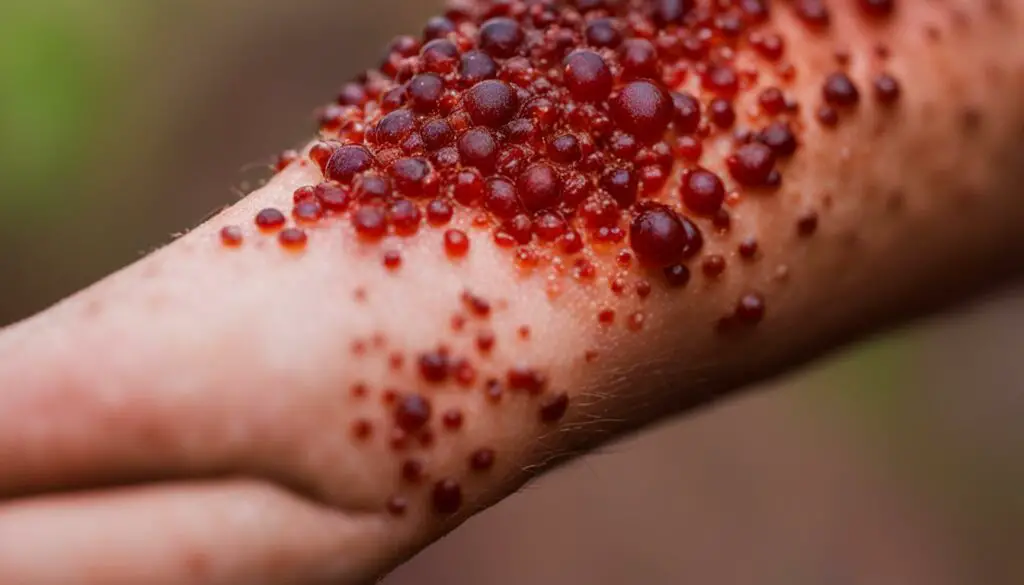
Key Points to Remember:
- Fire ants deliver a sting, not a bite.
- The venom from fire ant stings can cause a burning sensation, immediate pain, inflammation, and the formation of a white pustule.
- Some individuals may experience severe allergic reactions to fire ant stings, which require immediate medical attention.
- First aid measures, such as washing the affected area and applying cold compresses, can help alleviate the symptoms of fire ant stings.
- For severe symptoms or signs of an allergic reaction, seek prompt medical care.
Remember, prevention is always the best approach when it comes to fire ants. Avoiding their nests and taking proactive measures to keep them away from your home and yard can help minimize the risk of fire ant stings.
Professional Fire Ant Elimination: When to Seek Help
Dealing with a fire ant infestation can be a frustrating and challenging task. While some may attempt DIY pest control methods, it’s important to recognize the limitations of these approaches and know when it’s time to seek professional assistance. Professional pest control services offer expertise, specialized equipment, and responsible treatment methods that can effectively manage fire ants in Conroe and ensure the comprehensive treatment of the entire colony.
One of the key advantages of professional fire ant elimination is the knowledge and experience that pest control experts bring to the table. They are trained to identify and locate fire ant nests, even when they are hidden deep underground. By targeting the queen and her underground network, professionals can disrupt the reproductive cycle and significantly reduce the population of fire ants on your property.
Furthermore, professional pest control services use safe and effective treatments that are tailored to the specific needs of your infestation. They are knowledgeable about the latest products and techniques that are both environmentally friendly and highly efficient in eradicating fire ants. By relying on professionals, you can be confident that the treatments used will not harm your family, pets, or the surrounding environment.
When should you consider professional fire ant elimination?
- If you have a large fire ant infestation that covers a significant area of your property
- If previous DIY methods have been unsuccessful in controlling the fire ant population
- If you are dealing with fire ants in sensitive areas such as near children’s play areas, schools, or healthcare facilities
- If you have allergies or health conditions that make fire ant stings particularly dangerous
- If you want a long-term solution to prevent fire ants from returning and causing further disruption
Remember, prevention is always better than dealing with an established infestation. Regular monitoring, proper yard maintenance, and implementing preventive measures can help reduce the risk of fire ants invading your property. However, if you find yourself facing a persistent or extensive fire ant problem, it’s best to consult with a professional pest control service to ensure effective and long-lasting elimination.
Prevention: Keeping Fire Ants at Bay
When it comes to dealing with fire ants, prevention is key. By implementing proactive measures and staying vigilant, you can significantly reduce the chances of fire ant infestations in your yard and home. Here are some effective fire ant prevention tips and control measures to keep these pesky insects at bay:
1. Maintain a Clean Yard
Regular yard cleanup is essential to eliminate potential nesting sites for fire ants. Remove any debris, logs, or piles of leaves that can provide shelter for these insects. Keep your lawn well-maintained, mowing it regularly and trimming vegetation away from the house to create a less attractive environment for fire ants.
2. Smart Food Storage
Fire ants are attracted to food sources, both indoors and outdoors. To prevent these ants from entering your home, store food in airtight containers and clean up any spills or crumbs immediately. Outdoors, make sure garbage cans have tight-fitting lids and are emptied regularly to avoid attracting fire ants.
3. Natural Defenses
There are natural remedies that can help deter fire ants. For example, sprinkling cinnamon or coffee grounds around ant-prone areas can discourage them from nesting. Additionally, planting ant-repelling plants such as mint, lavender, or marigolds around your yard can create a natural barrier against fire ants.
By following these fire ant prevention tips and control measures, you can effectively minimize the risk of fire ant infestations in your home and yard. Remember, early intervention is crucial, and seeking professional pest control assistance may be necessary if you discover a full-blown infestation. With a proactive approach, you can enjoy a fire ant-free environment and protect your family and pets from their painful stings.
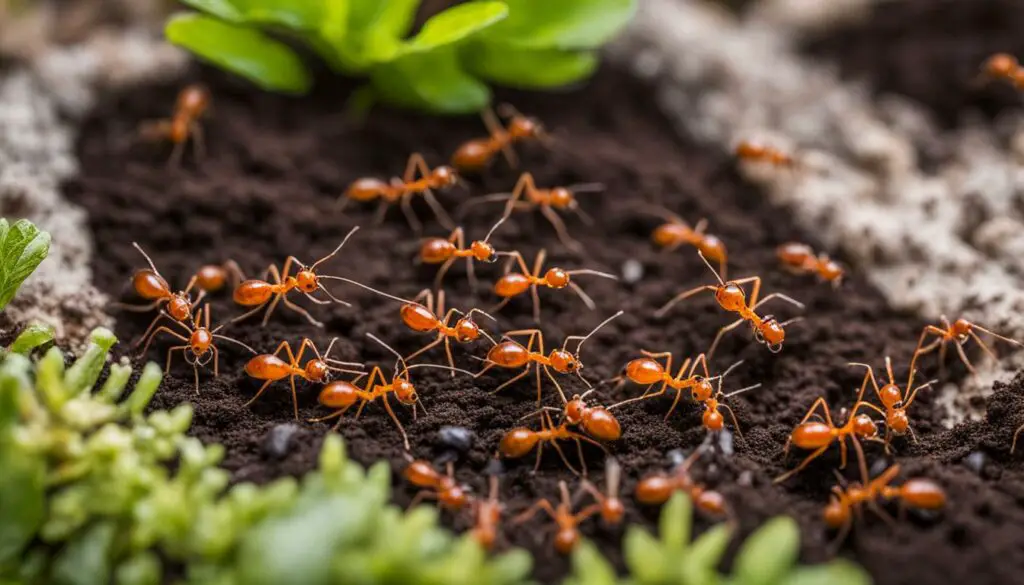
Conclusion
Throughout this article, we have explored the fascinating world of ant tunneling behavior patterns and the complex structures they create. The research conducted by the Caltech team has provided valuable insights into the mechanisms behind ant tunnel construction, shedding light on how these tiny creatures build long-lasting tunnels.
On the other hand, fire ants present unique challenges due to their aggressive behavior and distinctive characteristics. Effective fire ant control and prevention strategies are crucial to minimize their impact on our daily lives. By understanding their behavior, seeking professional assistance when needed, and implementing preventive measures, we can coexist with these resilient insects.
So, whether we marvel at the intricate tunneling behavior patterns of ants or seek ways to control fire ant infestations, it is clear that ants play a significant role in our ecosystem. Through ongoing research and responsible pest management techniques, we can continue to learn from these remarkable creatures and find ways to peacefully cohabitate with them.
FAQ
What is the driving question behind studying ant tunneling behavior?
The driving question is whether ants “know” how to dig tunnels or if their digging is a blind process.
How do ants construct their tunnels efficiently?
Ants dig their tunnels along the inside edges of containers, utilizing the container’s structure to minimize their workload.
What is the angle of repose and how do ants utilize it?
The angle of repose is the steepest angle at which a material remains stable. Ants dig their tunnels as steeply as the angle of repose allows, ensuring the stability of the tunnel walls.
How do ants rearrange the force chains around their tunnels?
By removing grains of soil in a specific pattern, ants subtly rearrange the force chains around the tunnel, strengthening the walls and relieving pressure from the areas where they are working.
What can we learn from ant nest engineering?
Ant nest engineering provides insights into swarm intelligence, efficient resource allocation, and resilient infrastructure design, which can be applied to various fields such as computer networks, architectural structures, and sustainable building practices.
What are the distinguishing characteristics of fire ants?
Fire ants have elongated bodies, stingers, and segmented bodies, which set them apart from other ant species. Their nests can be identified by their reddish-brown color.
How do fire ants behave when their nests are disturbed?
Fire ants are known for their aggressive behavior and quick retaliation when their nests are disturbed. They defend their colony fiercely, making them formidable opponents in the insect world.
What do fire ants eat?
Fire ants have an opportunistic diet and consume plants, small insects, seeds, fruits, and even worms. They may also venture into homes in search of sweet or protein-rich foods.
What is the difference between a fire ant sting and a bite?
Fire ants deliver a sting, not a bite, which involves the injection of venom. This sting causes a burning sensation, inflammation, and the formation of a white pustule.
When should professional fire ant elimination services be sought?
Professional pest control services should be called when dealing with a fire ant infestation to ensure the comprehensive treatment of the entire colony, targeting the queen and her underground network.
How can fire ants be prevented from infesting yards and homes?
Preventing fire ants requires consistent yard maintenance, regular mowing, removal of clutter, smart food storage, and implementing natural deterrents to keep them away from homes.

